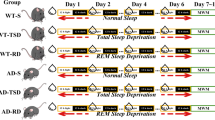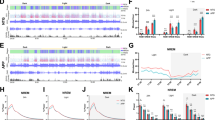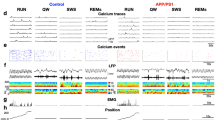Abstract
Sleep disturbances are prevalent among patients with Alzheimer’s disease (AD) and often precede the onset and progression of dementia. However, there are no reliable animal models for investigating sleep disturbances in patients with sporadic AD (sAD), which accounts for more than 90% of all AD cases. In the present study, we characterize the sleep/wake cycles and explore a potential mechanism underlying sleep disturbance in a rat model of sAD induced via intracerebroventricular (icv) injection of streptozotocin (STZ). STZ-icv rats exhibited progressive decreases in slow wave sleep (SWS) during the light phase and throughout the light/dark cycle beginning from 7 days after STZ-icv. Additionally, increased wakefulness and decreased rapid-eye-movement (REM) and non-REM (NREM) sleep were observed from 14 days after STZ-icv. Beginning on day 7, STZ-icv rats exhibited significant decreases in delta (0.5–4.0 Hz) power accompanied by increased power in the beta (12–30 Hz) and low gamma bands (30–50 Hz) during NREM sleep, resembling deficits in sleep quality observed in patients with AD. Immunohistochemical staining revealed a significant reduction in the ratio of c-Fos-positive GABAergic neurons in the parafacial zone (PZ) beginning from day 7 after STZ-icv. These results suggest that the STZ-icv rat model is useful for evaluating sleep disturbances associated with AD, and implicate the dysregulation of GABAergic neuronal activity in the PZ is associated with sleep disturbance induced by STZ.





Similar content being viewed by others
References
Anaclet C, Lin JS, Vetrivelan R, Krenzer M, Vong L, Fuller PM, Lu J (2011) Identification and characterization of a sleep-active cell group in the rostral medullary brainstem. J Neurosci 32:17970–17976
Anaclet C, Ferrari L, Arrigoni E, Bass CE, Saper CB, Lu J, Fuller PM (2014) GABAergic parafacial zone is a medullary slow–wave–sleep promoting center. Nat Neurosci 17:1217–1224
Chen Y et al (2013) A non-transgenic mouse model (icv-STZ mouse) of Alzheimer's disease: similarities to and differences from the transgenic model (3xTg-AD mouse). Mol Neurobiol 47:711–725
Colas D, Cespuglio R, Sarda N (2005) Sleep wake profile and EEG spectral power in young or old senescence accelerated mice. Neurobiol Aging 26:265–273
Colbymilley J, Cavanagh C, Jego S, Breitner JC, Quirion R, Adamantidis A (2015) Sleep-wake cycle dysfunction in the TgCRND8 mouse model of Alzheimer's disease: from early to advanced pathological stages. PLoS One 10:e0130177–e0130177
Correia SC, Santos RX, Perry G, Zhu X, Moreira PI, Smith MA (2011) Insulin-resistant brain state: the culprit in sporadic Alzheimer's disease? Ageing Res Rev 10:264–273
Cui SY et al (2016) Ca(2+) in the dorsal raphe nucleus promotes wakefulness via endogenous sleep-wake regulating pathway in the rats. Molecular Brain 9:71–71
Duncan MJ et al (2012) Effects of aging and genotype on circadian rhythms, sleep, and clock gene expression in APPxPS1 knock-in mice, a model for Alzheimer's disease. Exp Neurol 236:249–258
Hamm V, Héraud C, Cassel JC, Mathis C, Goutagny R (2015) Precocious alterations of brain oscillatory activity in Alzheimer’s disease: a window of opportunity for early diagnosis and treatment. Front Cell Neurosci 9:491–491
Holth J, Patel T, Holtzman DM (2017a) Sleep in Alzheimer's disease - beyond amyloid. Neurobiology of Sleep & Circadian Rhythms 2:4–14
Holth JK, Mahan TE, Robinson GO, Rocha A, Holtzman DM (2017b) Altered sleep and EEG power in the P301S tau transgenic mouse model. Annals of Clinical & Translational. Neurology 4:180–190
Iqbal K, Grundke-Iqbal I (2010) Alzheimer's disease, a multifactorial disorder seeking multitherapies. Alzheimers & Dementia the Journal of the Alzheimers Association 6:420–424
Ju YE (2014) Sleep and Alzheimer disease pathology--a bidirectional relationship. Nat Rev Neurol 10:115–119
Ju YE et al (2013) Sleep quality and preclinical Alzheimer disease. JAMA Neurol 70:587–593
Jyoti A, Plano A, Riedel G, Platt B (2010) EEG, activity, and sleep architecture in a transgenic AβPPswe/PSEN1A246E Alzheimer's disease mouse. Journal of Alzheimers Disease Jad 22:873–887
Jyoti A, Plano A, Riedel G, Platt B (2015) Progressive age-related changes in sleep and EEG profiles in the PLB1Triple mouse model of Alzheimer's disease. Neurobiol Aging 36:2768–2768
Khan MB, Ahmad M, Ahmad S, Ishrat T, Vaibhav K, Khuwaja G, Islam F (2015) Bacopa monniera ameliorates cognitive impairment and neurodegeneration induced by intracerebroventricular-streptozotocin in rat: behavioral, biochemical, immunohistochemical and histopathological evidences. Metab Brain Dis 30:115–127
Knezovic A, Osmanovic-Barilar J, Curlin M, Hof PR, Simic G, Riederer P, Salkovic-Petrisic M (2015) Staging of cognitive deficits and neuropathological and ultrastructural changes in streptozotocin-induced rat model of Alzheimer's disease. J Neural Transm 122:577–592
Lee Y et al (2014) Insulin/IGF signaling-related gene expression in the brain of a sporadic Alzheimer's disease monkey model induced by intracerebroventricular injection of streptozotocin. Journal of Alzheimer's disease : JAD 38:251–267
Lim MM, Gerstner JR, Holtzman DM (2014) The sleep–wake cycle and Alzheimer’s disease: what do we know? Neurodegenerative Disease Management 4:351–362
Mander BA, Winer JR, Jagust WJ, Walker MP (2016a) Sleep: a novel mechanistic pathway, biomarker, and treatment target in the pathology of Alzheimer's disease? Trends Neurosci 39:552–566
Mander BA, Winer JR, Jagust WJ, Walker MP (2016b) Sleep: a novel mechanistic pathway, biomarker, and treatment target in the pathology of Alzheimer's disease? Trends Neurosci 39:552–552
Musiek ES, Xiong DD, Holtzman DM (2015) Sleep, circadian rhythms, and the pathogenesis of Alzheimer disease. Exp Mol Med 47:e148–e148
Paweł G (2016) Intracerebroventricular Streptozotocin injections as a model of Alzheimer’s disease: in search of a relevant mechanism. Mol Neurobiol 53:1741–1752
Paxinos G, Watson C (2014) Paxinos and Watson's the rat brain in stereotaxic coordinates. Academic Press, Cambridge
Peter-Derex L, Yammine P, Bastuji H, Croisile B (2015) Sleep and Alzheimer's disease. Sleep Med Rev 19:29–38
Ravelli KG, Rosário BDA, Camarini R, Hernandes MS, Britto LR (2016) Intracerebroventricular Streptozotocin as a model of Alzheimer’s disease: neurochemical and behavioral characterization in mice. Neurotox Res:1–7
Rothman SM, Mattson MP (2012) Sleep disturbances in Alzheimer’s and Parkinson’s diseases. NeuroMolecular Med 14:194–204
Saper CB, Fuller PM (2017) Wake-sleep circuitry: an overview. Curr Opin Neurobiol 44:186–186
Schneider F, Baldauf K, Wetzel W, Reymann KG (2014) Behavioral and EEG changes in male 5xFAD mice. Physiol Behav 135:25–25
Sethi M et al (2015) Increased fragmentation of sleep-wake cycles in the 5XFAD mouse model of Alzheimer's disease. Neuroscience 290:80–89
Siwek ME et al (2015) Altered theta oscillations and aberrant cortical excitatory activity in the 5XFAD model of Alzheimer's disease. Neural Plasticity 2015:781731–781731
Song JZ, Sun J, Jin DC, Deng YQ (2014) Rosiglitazone improves learning and memory impairment of 3 x Tg mice. Yao xue xue bao = Acta pharmaceutica Sinica 49:807–812
Urrestarazu E, Iriarte J (2016) Clinical management of sleep disturbances in Alzheimer's disease: current and emerging strategies. Nature and science of sleep 8:21–33
Van Someren EJ, Van Der Werf YD, Roelfsema PR, Mansvelder HD, da Silva FH (2011) Slow brain oscillations of sleep, resting state, and vigilance. Prog Brain Res 193:3–15
Wang ZJ et al (2015) Glucocorticoid receptors in the locus coeruleus mediate sleep disorders caused by repeated corticosterone treatment. Sci Rep 5:9442–9442
Yeo HG et al (2015) Characterization of cerebral damage in a monkey model of Alzheimer's disease induced by Intracerebroventricular injection of Streptozotocin. Journal of Alzheimer's disease : JAD 46:989–1005
Yu B et al (2016) Mechanisms underlying Footshock and psychological stress-induced abrupt awakening from posttraumatic “nightmares”. Int J Neuropsychopharmacol 19:pyv113–pyv113
Acknowledgements
This study was funded by grants from the National Natural Science Foundation of China (No. 81573407, 81302746 and 81202511).
Author information
Authors and Affiliations
Corresponding author
Ethics declarations
Conflict of interest
The authors declare that there are no competing interests.
Rights and permissions
About this article
Cite this article
Song, JZ., Cui, SY., Cui, XY. et al. Dysfunction of GABAergic neurons in the parafacial zone mediates sleep disturbances in a streptozotocin-induced rat model of sporadic Alzheimer’s disease. Metab Brain Dis 33, 127–137 (2018). https://doi.org/10.1007/s11011-017-0125-y
Received:
Accepted:
Published:
Issue Date:
DOI: https://doi.org/10.1007/s11011-017-0125-y




